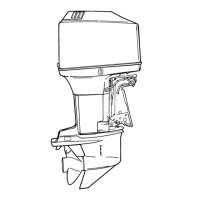90-824052R3 JUNE 2002 IMPORTANT INFORMATION - 1C-1
Serial Number Location
The engine serial number is located on the lower
starboard side of the engine block. A serial number
is also located on the starboard side of the swivel
bracket.
19XX
XX
OGXXXXXX
XXXX
a
e
d
c
b
a - Serial Number d - Year Manufactured
b - Model Year e - Certified Europe Insignia
c - Model Designation
Conditions Affecting
Performance
Weather
Weather conditions exert a profound effect on power
output of internal combustion engines. Established
horsepower ratings refer to the power that the engine
will produce at its rated RPM under a specific combi-
nation of weather conditions.
Corporations internationally have settled on adop-
tion of I.S.O. (International Standards Organization)
engine test standards, as set forth in I.S.O. 3046
standardizing the computation of horsepower from
data obtained on the dynamometer, correcting all val-
ues to the power that the engine will produce at sea
level, at 30% relative humidity at 77° F (25°C) tem-
perature and a barometric pressure of 29.61 inches
of mercury.
Summer conditions of high temperature, low baro-
metric pressure and high humidity all combine to re-
duce engine power. This is reflected in decreased
boat speeds – as much as 2 or 3 mph. Nothing will
regain this speed for the boater but the coming of
cool, dry weather.
In pointing out the consequences of weather effects,
an engine – running on a hot, humid summer day –
may lose as much as 14% of the horsepower it would
produce on a dry, brisk spring or fall day. The horse-
power that any internal combustion engine produces
depends upon the density of the air that it consumes
and this density is dependent upon the temperature
of the air, its barometric pressure and water vapor (or
humidity) content.
Accompanying this weather-inspired loss of power is
a second but more subtle loss. At rigging time in early
spring, the engine was equipped with a propeller that
allowed the engine to run within its recommended
RPM range at full throttle. With the coming of the
summer weather and the consequent drop in avail-
able horsepower, this propeller will, in effect, become
too large. Consequently, the engine operates at less
than its recommended RPM.
Due to the horsepower/RPM characteristics of an en-
gine, this will result in further loss of horsepower at
the propeller with another decrease in boat speed.
This secondary loss can be regained by switching to
a smaller pitch propeller that allows the engine to run
again at recommended RPM.
To obtain optimum engine performance under
changing weather conditions, the engine MUST be
propped to allow it to operate at or near the top end
of the recommended maximum RPM range at wide-
open-throttle with a normal boat load.
This will allow the engine to develop full power while
operating in an RPM range that discourages damag-
ing detonation.

